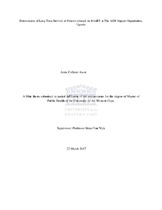| dc.contributor.advisor | Van Wyk, Brian | |
| dc.contributor.author | Awor, Anna Colletar | |
| dc.date.accessioned | 2017-09-28T15:41:05Z | |
| dc.date.available | 2017-09-28T15:41:05Z | |
| dc.date.issued | 2017 | |
| dc.identifier.uri | http://hdl.handle.net/11394/5595 | |
| dc.description | Master of Public Health - MPH | en_US |
| dc.description.abstract | It is well documented that mortality rates have decreased and the survival of HIV and AIDS patients has been prolonged since the introduction of highly active antiretroviral therapy (HAART) in 1996. Although HAART has dramatically improved the prognosis of HIV disease, some HIV patients on HAART still die of HIV related illnesses. It is important to understand what these factors are in order to mitigate the impact on these factors on patient survival and achieve better outcome for these patients. The aim of this study was to determine risk factors for long term survival of patients on HAART in Uganda. Data for 2,244 out of 30,000 clients receiving care and treatment at TASO Entebbe was retrospectively analyzed. TASO Entebbe is a non-governmental HIV clinic that provides care and treatment to HIV positive clients. Long term survival in this case was defined as survival for more than 5 years after initiation on HAART. Logistic regression and survival analysis were conducted. Female clients had a 12% lower risk of death compared to the male clients (AHR=0.88 [CI: 0.443- 0.936]). Clients that had pulmonary TB had 1.3 times higher risk of death compared to clients that did not have pulmonary TB (AHR=1.33 [CI: 1.162-2.733]). Clients initiated at CD4 cell counts less than 250 cells/μl had almost 7 times higher adjusted odds of death compared to those initiated at CD4 cell counts greater than 500 cells/μl (AOR= 6.95 [CI: 2.882-16.744]) and clients initiated at CD4 cell counts between 250 cells/μl and 500 cells/μl almost 3 times higher adjusted odds of death compared to clients initiated at CD4 cell counts greater than 500 cells/μl (AOR 2.56 [CI: 1.004-6.520]). It is recommended that an aggressive HIV testing strategy be put in place to facilitate early identification of HIV positive patients. Early identification would enable early initiation into HAART well before the CD4 cell counts fall below 500 cells/μl. The observed higher risk of mortality amongst men suggests interventions to promote early HIV testing and treatment initiation amongst men. The observed high risk of mortality for patients with pulmonary TB, calls for aggressive TB case finding and treatment of positive in order to reduce the HIV/TB related mortality. | en_US |
| dc.language.iso | en | en_US |
| dc.publisher | University of the Western Cape | en_US |
| dc.subject | Antiretroviral therapy | en_US |
| dc.subject | Antiretroviral drug | en_US |
| dc.subject | Highly active antiretroviral therapy | en_US |
| dc.subject | Sub-Saharan Africa | en_US |
| dc.subject | HIV/AIDS | en_US |
| dc.subject | Mortality | en_US |
| dc.title | Determinants of long term survival of patients initiated on HAART at the AIDS support organization, Uganda | en_US |
| dc.rights.holder | University of the Western Cape | en_US |

